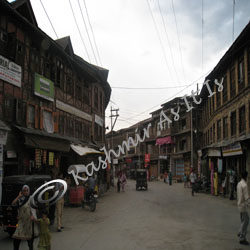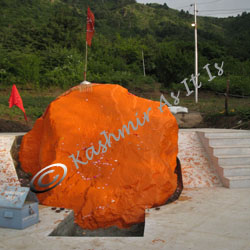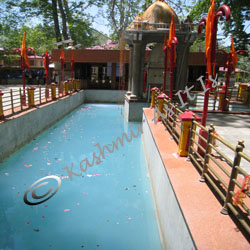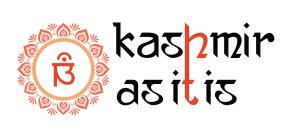Talking of the heritage of Kashmir, it can be said that it stands beyond any cultural or the racial barriers for the monuments of all the three religions stand here in peace and harmony. The love among the communities to preserve our heritage is prominent in the valley which makes our heritage not only mutually existing but also multi-dimensional.
Kashmir Old City
 The old city can be defined as an area for jaded travellers and photographers. Traditionally dressed men and women can be seen purchasing goods all over the hustling and bustling market. Go in the narrow lanes and they will lead you to the old mosques, ancient temples, some burnt buildings, abandoned houses and may be village life as well. The mood of the old city swings from one corner to another. From the ticking of the clock tower in lal chowk to the cries of the fisherwomen all is worth a watch. Walk along the river Jhelum and you can have a peep to the historical architecture through the seven old bridges still standing against the slaps of the time. You can have boat rides, autos or may be just walk to enjoy the aspect of old city life.
The old city can be defined as an area for jaded travellers and photographers. Traditionally dressed men and women can be seen purchasing goods all over the hustling and bustling market. Go in the narrow lanes and they will lead you to the old mosques, ancient temples, some burnt buildings, abandoned houses and may be village life as well. The mood of the old city swings from one corner to another. From the ticking of the clock tower in lal chowk to the cries of the fisherwomen all is worth a watch. Walk along the river Jhelum and you can have a peep to the historical architecture through the seven old bridges still standing against the slaps of the time. You can have boat rides, autos or may be just walk to enjoy the aspect of old city life.
Hazratbal Mosque
Located on the banks of the Dal lake, Hazrat-Bal Mosque is of a religious significance in Kashmir. It is said that this mosque houses the hair of the Prophet Muhammad, which is shown to the public only on auspicious days. The mosque apart from its religious sanctity, because of its location gives the best scenic view of Dal Lake and mountains beyond the lake.
Shah-i-Hamdan
Shah-i-hamdan is of historical importance as this is the first mosque built in the valley by Mir Sayyed Ali Hamdani in AD 1395 who was a traveller from Persia and also cnsidered to be responsible for spreading Islam in Kashmir. It is situated on the banks of the Jhelum river between the third and the fourth bridge. The interior of the mosque or Khankah is richly carved and painted and decorated with ancient chandeliers.
Jama Mazjid
Jama Mazjid is another mosque of religious importance in the valley where floks of people come every Friday to offer prayers. This mosque was built by Sultan Sikandar in 1400 AD, and then enlarged around a coutyard supported by 370 wooden pillars by his son Zail-Ul-Abidin. The mosque is a typical example of Indo-Sarcenic Architecture. As per the history, this mosque has been destroyed by fire three times and re-built everytime, however the mosque stands preserved and repaired since the reign of Maharaja Pratap Singh.
Shankrachariya
The site of the Shankrachariya temple dates back to 350 BC. This is place where the philosopher ‘Shankracharya’ stayed during his stay in Kashmir to spread the ‘Sanatan Dharma’.
Dasgeer Sahib
Dasgeer Sahib is another shrine of the religious as well as spiritual importance in Kashmir.
Hari Parbat
 Hari Parbat – as the name says – Holy Hill – is considered to be the sacred place for the Hindu community. It is believed that on this Parbat the Godess Shakti resides, thus this place is also known as Sharika Peeth. Noticing the spiritual and religious importance of this hill, Akbar built the wall around the hill to keep the deity safe in 1592-98AD. Later the Hari Parbat fort was built by an Afghan governer Ata Mohammad Khan in 18th century. This fort is beautified with apple orchards and spring blossoms.
Hari Parbat – as the name says – Holy Hill – is considered to be the sacred place for the Hindu community. It is believed that on this Parbat the Godess Shakti resides, thus this place is also known as Sharika Peeth. Noticing the spiritual and religious importance of this hill, Akbar built the wall around the hill to keep the deity safe in 1592-98AD. Later the Hari Parbat fort was built by an Afghan governer Ata Mohammad Khan in 18th century. This fort is beautified with apple orchards and spring blossoms.
Makhdoom Sahib
Makhdoom Sahib is the historical shrine resting on the southern side of Hari Parbat. This shrine is of religious importance and is being visited by the people of all faiths.
Kheer Bhawani
Kheer Bhawani temple is a sacred Hindu temple in the valley. The temple is constructed within the spring which is believed to magically change its color with the change in the season or to warn a disaster. On the Ashtami, thousands of devotees flok to the temple and offer Kheer to the goddess.
Imambara Zadibal
The Imambara built by Kaji Chek in 1518AD was desecrated by fire eleven times in the course of centuries. However in the reign of Maharaja Ranbir Singh (1872AD) this historic Imambara was reconstructed in Persian style of architecture with two storeyed building standing in over 75square meter area.
Chatti Patshahi
Chatti Patshahi Gurudwara has been built exactly on the site where the Sixth Sikh Guru stopped to preach Sikhism. It is situated in Rainawari and is visited by people of all faiths.
Martand Temple
 Martand Temple is the most ancient temple dedicated to Sun God. It was built in 5th century AD by King Laitaditya. The temple is humongous having 84 columns. Standing on the poarch of the temple gives the 360degree view of the whole Kashmir Valley.
Martand Temple is the most ancient temple dedicated to Sun God. It was built in 5th century AD by King Laitaditya. The temple is humongous having 84 columns. Standing on the poarch of the temple gives the 360degree view of the whole Kashmir Valley.
Parihaspora – Bhuddist temple
The ruins of some Bhuddist sites have been preserved to this date. These ruins date back to 695-731AD.Within the limits of this ancient city , the prominent structures which the King raised include: Govardhan, Mukta Keshav, Parhas Keshav, Mahavrah and Raj Vihar. The devastation of these monuments was a result of wars fought between the local rulers and King Sikandar. Some historians say that the vihars found in these site date back 79-15BC. It is also said that the world’s third Buddhist conference was held here.
Awantipura Temple
The Avantipura ruins depicts the township of the valley dated 7th century. The site preserves two ancient temples – one of Lord Shiva and the other of Lord Vishnu.
Harwan – Bhuddist temple
Harwan was actually called Shadarahawan which means the woods of six saints. This is another site where Buddhist ruins have now been preserved by the archelogical association. These ruins date back to the Kushan period i.e. around 300 AD. These ruins were discovered by the archeological team during the excavation between 1919-1929 AD. This place also has the footprints of the civilization. Some of the ruins excavated included painted tiles depicting image of humans and many other artifacts. In this site, two springs also stay prominent which are believed to be used to fetch water for drinking purpose by the locals.
Burzama Ruins
The excavation of this site by Archaeological Department in 1961, reveiled ancient artifacts and utensils. These ruins date back to the Neolithic Age signifying mud settlements, earthen utensils, bone utensils & tools, raw bricks.
Chaar-e-sharif
Also called as Charar-e-sharif. This town is famous for for the tomb of Hazrat Sheikh Noor-u-din Noorani, who preached Islam through his poetry. This shrine is one of the most sacred shrines for the Muslims in India. According to the legend, after the death of Hazrat Sheikh Noor-u-din Noorani also called Alamdar-e-Kashmir, his coffin, after flying some distance landed at the site where the mosque stands today. This shrine is said to be approximately 600 years old. There are many legends and tales associated with this sufi saint. He was born as Nund Reshi or Sahazanand to Salar Sanz in 1377. It is said that he denied drinking milk till the third day of his birth until the female saint Lal Daed fed him her own milk. While leaving the house she said that the child would be her spiritual heir. He was the one to start Rishism in the valley and he started Rishi Mat or Vishnu Mat in the valley. He preached communal harmony, vegetarianism and non-voilence throughout his life. He was called by different names by the different sect of the followers. Nund Rishi is also known as Sheikh-ul-Alam, Sheikh Noor-ud-Din Noorani, Alamdar-e-Kashmir, Sarkhel-e-Rishiya, etc. This shrine is revered and respectable place for both Hindu and Muslim sects of the valley since it is the final resting place of the great saint. The shrine has been destroyed twice – once by Mujaheedins, which was later reconstructed and other by fire in 1995.
Budshah Tomb
Budshah tomb being the final resting place of Sultan Zain-Ul-Abidin [1420 AD to 1470 AD] is of historical importance. He is said to be one of the most respectable kings of the valley. During his reign and lifetime in Kashmir, spanning over 50 years of the late 15th Century AD, famed to be one of the most peaceful and successful existence. He was known for being spiritually enlightened and highly reputed for the restructuring of the architecture of Kashmir. Thus he was conferred the title – Budshah or the Great king. Tomb is an excellent representation of a typical Shahmiri style which cannot be seen anywhere else in the valley.
Read more and in details about these places and more in our PLACES OF HERITAGE PAGE





